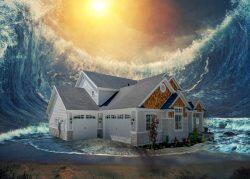Fire, water and freezing temperatures last year posed increasingly dangerous — and expensive — concerns for homeowners across the U.S.
Natural disasters caused $56.9 billion in property damage in 2021, according to a new climate change catastrophe report from CoreLogic. Wildfires, floods, twisters and winter freezes hit nearly every major market with no signs of slowing down.
Even as waterfront areas beefed up flood defenses and insurance policies, property damage from hurricanes along the Gulf Coast and Northeast totaled $33 billion. The storms threatened 1.23 million homes, which would require $395.4 billion in reconstruction costs if leveled by future storms.
Last year’s hurricanes also showed how climate change damage can ripple up to corporate balance sheets. Mortgage delinquencies nearly doubled in Houma, Louisiana, after Hurricane Ida hit in August, reaching 13.5 percent in October.
Winter storms threatened the broadest swath of land in the country of any type of catastrophe, freezing 12.7 million homes in the central US from Texas to Fargo. Many of the homes in freeze zones lack insulation and pipe protection as the storms caused $15 billion in property damage last year.
Severe weather events like tornadoes, hailstorms and heavy winds battered much of the Midwest and Southeast. In all, the 563,600 homes in their path weathered $7.5 billion in property damage, according to CoreLogic. The costs weren’t just financial: the December 10 tornadoes in the central and southern U.S. killed 80 people across eight states, the month’s deadliest twister count in recorded history.
The National Oceanic and Atmospheric Administration points out that such severe storms typically occur in warmer months. “The very fact that tornadoes of this intensity struck in late autumn, rather than in the spring and summer when thunderstorms and tornadoes are more likely, is remarkable,” the administration wrote in its response to the catastrophe.
Wildfires concentrated in Northeastern California, with the Dixie Fire scorching over 1,200 structures across 1 million acres. Smoke and ash are still causing problems in nearby homes, with the total costs of the fires reaching $1.5 billion for 4,100 homes in 2021. The problems are even hitting homeowners’ pocketbooks outside the burn zones, as written premiums for fire and homeowners insurance in California reached $11.1 billion in 2020, up 27 percent from 2017.
Read more


In the face of such destruction, many choose to skip town altogether, leaving devastated areas with fewer people to sustain their local economies.
One study analyzing cell phone data, social media posts and census numbers estimated anywhere between 123,000 and 476,000 Puerto Ricans left the island after Hurricane Maria. Over four years later, Puerto Rico’s infrastructure and homes still haven’t recovered.
For those that stay, construction costs have reached new heights. While costs have leveled off somewhat from their pandemic highs, supply chain issues keep builders scrambling for standard home components like garage doors and plumbing fixtures.
